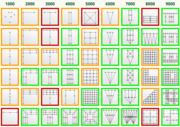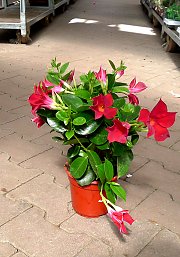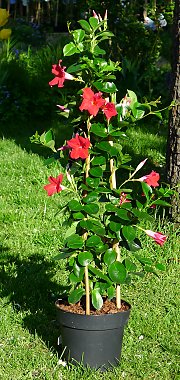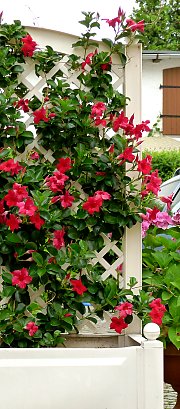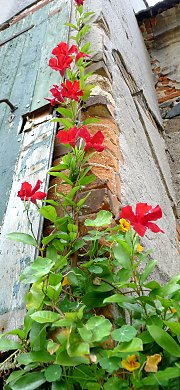Mandevilla Varieties and Climbing Aids
Only large, pre-grown mandevilla are suitable for facade greening. FassadenGrün offers a large range of this type, with flowers in many colours. How to choose? While your initial selection will likely be based on flower colour, the growth rate is the second factor to consider. For every mandevilla, we indicate its growth type: S, M, L or XL, some of which require climbing aids. You may find additional information on mandevilla under general information and planting / care.
Flower Colours
Red is considered the classic mandevilla colour. Pink and white, and all their intermediate shades, are also very common. The yellow center provides some variety, as the sepals and calyx of almost all mandevilla are yellow! The apricot and completely yellow mandevilla are relatively new cultivars.
Growth Habit
Mandevilla / dipladenia are twining vines with slow to moderate growth. The distance between leaf pairs ("internodes") is relatively big, the flowers rather scattered. This is where breeding began. For decades, attempts have been made to increase flower density (closeness of blooms). Another practice is the treatment of the mandevilla with chemical growth inhibitors. The plants 'doped' in this way won't develop long shoots but take on the desired compact form. For walls, trellises, and railings, however, it is especially the large, voluble forms (with the long twining shoots) that are more interesting than the compact form! FassadenGrün has both in its assortment. The growth groups S, M, L and XL are described below and should help with your selection. These groups indicate the mandevilla's expected eventual growth size in length and volume, not the size upon delivery.
Growth Type "S": Compressed
About 90% of all mandevilla sold are treated with growth inhibitors and have a compressed and very stocky growth, so they hardly form any tendrilous shoots. We have described such mandevilla as "growth type S" (small). Most of them are planted as small "tufts" for the greening of graves, terraces, and balcony boxes. This type of mandevilla grows very slowly, focusing on flower development: in May it measures about 20 cm, in October about 30 - 40 cm. Such a tuft isn't capable of covering larger wall surfaces, neither from a planter/pot nor as a trellis plant; for this reason, Fassadengrün doesn't sell them.
Growth Type "M": Compact
Mandevilla treated with growth inhibitors are available in bigger sizes. Slightly larger than the small are the 60-80 cm high plants. Even so, they still won't grow very high before autumn-- at most to about 1 to 1.2 m in shoot length, which corresponds to a medium size for a mandevilla. We have named this group "growth type M" (medium). Mandevillas of the M group usually have fine, graceful stems and small to medium-sized, smooth and shiny leaves of average size. The flower clusters are relatively closely arranged. We sell them in a variety of forms: double arch, pyramid, or fan trellis. In terms of climbing plants, these are considered "shaped shrubs," even if the plants do not become lignified at all. Such specimens are interesting for facade greening, particularly as displays next to house entrances, shops, practices, law offices, etc..
Growth Type "L": Twining Vines
These mandevilla we designate as "large" will, by the end of autumn, have shoots about twice to three times as long as when delivered, and will display a natural, twining growth. These plants are not treated with growth inhibitors; they grow to about 2 m shoot length by the end of August, and even 2.5 m by autumn. They are therefore ideal for small to medium sized walls. Mandevillas from the "L" group have very thin, delicate shoots and small to medium-sized, smooth and shiny leaves. The flower clusters are relatively densely arranged; the single flowers last for about 10 days (except for the yellow variety "Citrine"). "L" group Mandevilla do not necessarily have to be attached to a facade trellis or railing, as they can also be cultivated like the "M" group as shrubs by using a standing pyramid trellis or a similar support (where the twining shoots wind themselves around the bamboo sticks in the planter).
Growth Type XL: Vigorous Twiner
The growth group "XL" (extra large) refers to the exceptional mandevilla varieties with particularly vigorous and high growth. That might sound risky, but unlike the voluble twiners like wisteria and silver lace vine, these mandevilla are easily tamed. These mandevilla plants are *not* treated with growth inhibitors and will grow up to 4 metres high by the end of August-- even up to 5 m by autumn. They grow quickly above windows and doors and have remarkably large, more or less ribbed, shiny leaves. The flower clusters are further apart than with the S or M varieties, and overall flower density is less. Individual flowers in this group last a relatively long time-- 10 to 16 days. To improve the flower density, some varieties are sold as 2 plants per pot-- this will be indicated in the product description.
The XL mandevillas can be purcahsed as bamboo pyramids. The strong shoots are then led directly to the wall trellis or the balcony railing from the top of the pyramid. Alternatively, the pyramids can also be used as uprights or stands (similar to growth group M), such that the mandevilla grows as a small bush; then the shoots can be manually wound downwards around the bamboo rods of the pyramid.
Climbing Aids for the Facade
Mandevilla have multiple, relatively unbranching shoots.The appropriate climbing aid depends on the growth type of the mandevilla. The growth types S ("compressed" / small) and M ("compact" / medium) don't need a support, whereas the L and XL types benefit from vertical cables. The axes need to be no more than 15 - 25 cm apart to have the vegetation be dense enough. Further apart and the mandevilla will take the form of vertical flower garlands/strands. Ropes, railings, grids of any kind, as well as thin rods are all suitable as climbing aids. The shoots are first attached on the outside or wrapped around the rope counterclockwise and, if necessary, tied with binding material. The plant will soon grow upwards in a looping manner. The height of the trellis should be adapted to the expected growth height. For growth type M -- max. 2.5 m; for growth type XL -- 3 m or more. Look to the bottom of this page for compatible cable systems. The easy and light versions are usually sufficient, but the medium-premium or medium-classic are visually the most appealing designs for these plants. As the twining shoots will not climb and attach to a horizontal access by themselves, they need help and will have to be tied on.
Suitable Cable Systems for Mandevilla L and XL
Please click on the graphic illustrations for details!
| = suitable | = of limited suitability | = unsuitable |


